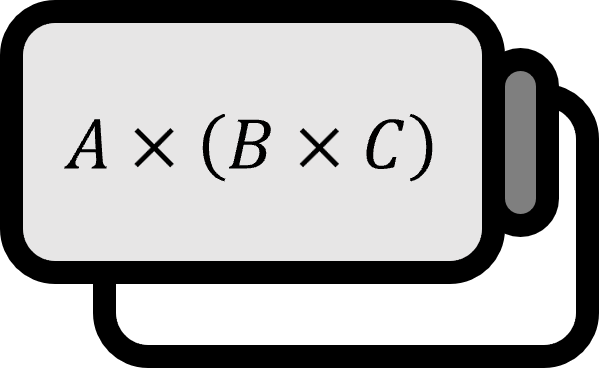Curvilinear Coordinates in Three-Dimensional Space
Buildup
The most common way to express a position in three-dimensional space is the Cartesian coordinate system. Named after Descartes, who devised it, it is also widely known as the orthogonal coordinate system. However, in specific situations, it might be difficult to represent the position using the Cartesian coordinate system. For instance, let’s consider an object performing rotational motion on a two-dimensional plane. Then, it would be much simpler to express the position of this object with $(r,\theta)$ rather than with $(x,y)$. Although referred to as specific situations, in reality, these situations appear quite often when solving physical problems. Therefore, there is a need to introduce a coordinate system other than the Cartesian coordinate system to solve such problems, and the well-arranged mathematical solution for this is the curvilinear coordinate system. A coordinate system in three-dimensional space must meet the following conditions to be considered appropriate:
- (a) It must be transformable to and from the Cartesian coordinate system.
- (b) Each coordinate’s direction must be perpendicular to each other.
Since there is no reason to create a new coordinate system if it cannot be transformed to and from the existing coordinate system, (a) is essential. Moreover, considering how mathematically useful the dot product is, a coordinate system that does not satisfy (b) would also not be a good coordinate system. Now let’s express the coordinates of the new curvilinear coordinate system with $q_{1}$, $q_{2}$, $q_{3}$. Thus, according to condition (a), it should be expressed as follows:
$$ \begin{equation*} \begin{aligned} x &= x(q_{1},q_{2},q_{3}) \\ y &= y(q_{1},q_{2},q_{3}) \\ z &= z(q_{1},q_{2},q_{3}) \end{aligned} \quad \text{and} \quad \begin{aligned} q_{1} &= q_{1}(x,y,z) \\ q_{2} &= q_{2}(x,y,z) \\ q_{3} &= q_{3}(x,y,z) \end{aligned} \end{equation*} $$
Also, let’s represent each coordinate’s unit vector with $\hat{\mathbf{q}}_{1}$, $\hat{\mathbf{q}}_{2}$, $\hat{\mathbf{q}}_{3}$. Furthermore, let’s assume the order of each coordinate follows the right-hand rule. This can be represented as follows with condition (b):
$$ \hat{\mathbf{q}}_{i}\cdot \hat{\mathbf{q}}_{j}=\delta_{ij} $$
$$ (\hat{\mathbf{q}}_{1}\times \hat{\mathbf{q}}_{2})\cdot \hat{\mathbf{q}}_{3}>0 $$
Since the area equals length$^{2}$, and volume equals length$^{3}$, let’s see how length is expressed in the curvilinear coordinate system. Suppose the coordinates of a certain position vector $\mathbf{r}$ changed slightly. However, considering various coordinate systems, the variables do not necessarily have to be in length units. For example, when the angle $\theta$ in the polar coordinate system changes, the distance the position changes is expressed as the arc length $l=r\theta$. Therefore, if something that corrects the components of $d\mathbf{r}$ to have the dimensions of length is called $h_{i}$, then $d\mathbf{r}$ can be expressed as follows:
$$ d\mathbf{r}=h_{1}dq_{1}\hat{\mathbf{q}_{1}}+h_{2}dq_{2}\hat{\mathbf{q}_{2}}+h_{3}dq_{3}\hat{\mathbf{q}_{3}} $$
Therefore, the square of the infinitesimal length is as follows:
$$ \begin{equation} ds^{2}=d\mathbf{r}\cdot d\mathbf{r}=(h_{1}dq_{1})^{2}+(h_{2}dq_{2})^{2}+(h_{3}dq_{3})^{2} \end{equation} $$
Moreover, the infinitesimal volume is as follows:
$$ dV=h_{1}h_{2}h_{3}dq_{1}dq_{2}dq_{3} $$
Now, let’s find out how something that corrects each component to have a length dimension, $h_{i}$, is expressed. Meanwhile, the change in $\mathbf{r}=\mathbf{r}(q_{1},q_{2},q_{3})$, known as the total differential, is as follows:
$$ d\mathbf{r}= \frac{ \partial \mathbf{r}}{ \partial q_{1}}dq_{1}+\frac{ \partial \mathbf{r}}{ \partial q_{2}}dq_{2}+\frac{ \partial \mathbf{r}}{ \partial q_{3}}dq_{3} $$
Then, the square of the length changed by $\mathbf{r}$ is as follows:
$$ \begin{equation} \begin{aligned} ds^{2} &= d \mathbf{r}^{2}=d\mathbf{r}\cdot d\mathbf{r} \\ &= \left( \frac{ \partial \mathbf{r}}{ \partial q_{1}}dq_{1}+\frac{ \partial \mathbf{r}}{ \partial q_{2}}dq_{2}+\frac{ \partial \mathbf{r}}{ \partial q_{3}}dq_{3} \right) \cdot \left( \frac{ \partial \mathbf{r}}{ \partial q_{1}}dq_{1}+\frac{ \partial \mathbf{r}}{ \partial q_{2}}dq_{2}+\frac{ \partial \mathbf{r}}{ \partial q_{3}}dq_{3} \right) \\ &= \frac{ \partial \mathbf{r}}{ \partial q_{1} }\cdot\frac{ \partial \mathbf{r}}{ \partial q_{1}}dq_{1}dq_{1} + \frac{ \partial \mathbf{r}}{ \partial q_{1} }\cdot\frac{ \partial \mathbf{r}}{ \partial q_{2}}dq_{1}dq_{2}+\frac{ \partial \mathbf{r}}{ \partial q_{1} }\cdot\frac{ \partial \mathbf{r}}{ \partial q_{3}}dq_{1}dq_{3} \\ &\quad + \frac{ \partial \mathbf{r}}{ \partial q_{2} }\cdot\frac{ \partial \mathbf{r}}{ \partial q_{1}}dq_{2}dq_{1} + \frac{ \partial \mathbf{r}}{ \partial q_{2} }\cdot\frac{ \partial \mathbf{r}}{ \partial q_{2}}dq_{2}dq_{2}+\frac{ \partial \mathbf{r}}{ \partial q_{2} }\cdot\frac{ \partial \mathbf{r}}{ \partial q_{3}}dq_{2}dq_{3} \\ &\quad + \frac{ \partial \mathbf{r}}{ \partial q_{3} }\cdot\frac{ \partial \mathbf{r}}{ \partial q_{1}}dq_{3}dq_{1} + \frac{ \partial \mathbf{r}}{ \partial q_{3} }\cdot\frac{ \partial \mathbf{r}}{ \partial q_{2}}dq_{3}dq_{2}+\frac{ \partial \mathbf{r}}{ \partial q_{3} }\cdot\frac{ \partial \mathbf{r}}{ \partial q_{3}}dq_{3}dq_{3} \end{aligned} \end{equation} $$
At this point, the following holds:
$$ \begin{align*} \frac{ \partial \mathbf{r}}{ \partial q_{i} } &= \frac{ \partial (x\hat{\mathbf{x}}+y\hat{\mathbf{y}}+\hat{z\mathbf{z}})}{ \partial q_{i} } \\ &= \frac{ \partial x}{ \partial q_{i}}\hat{\mathbf{x}}+\frac{ \partial y}{ \partial q_{i}}\hat{\mathbf{y}}+\frac{ \partial z}{ \partial q_{i}}\hat{\mathbf{z}} \end{align*} $$
Hence, the following is obtained:
$$ \frac{ \partial \mathbf{r}}{ \partial q_{i}}\cdot \frac{ \partial \mathbf{r}}{ \partial q_{j}} = \frac{ \partial x}{ \partial q_{i}}\frac{ \partial x}{ \partial q_{j}}+ \frac{ \partial y}{ \partial q_{i}}\frac{ \partial y}{ \partial q_{j}}+\frac{ \partial z}{ \partial q_{i}}\frac{ \partial z}{ \partial q_{j}} $$
If the above equation is simply represented by $g_{ij}=\frac{ \partial \mathbf{r}}{ \partial q_{i}}\cdot \frac{ \partial \mathbf{r}}{ \partial q_{j}}$, then $(2)$ is as follows:
$$ \begin{equation} \begin{aligned} ds^{2} &= g_{11}dq_{1}^{2}+g_{12}dq_{1}dq_{2}+g_{13}dq_{1}dq_{3} \\ &\quad + g_{21}dq_{2}dq_{1}+g_{22}dq_{2}^{2}+g_{23}dq_{2}dq_{3} \\ &\quad + g_{31}dq_{3}dq_{1}+g_{32}dq_{3}dq_{2}+g_{33}dq_{3}^{2} \\ &= \sum \limits _{i,j=1}^{3}g_{ij}dq_{i}dq_{j} \end{aligned} \end{equation} $$
Now, if we compare $(1)$ and $(3)$, the result is as follows:
$$ g_{ij}=\begin{cases} h_{i}^{2}, &i=j \\ 0, &i\ne j \end{cases} $$
Here, $h_{i}=\sqrt{g_{ii}}=\sqrt{\dfrac{ \partial \mathbf{r}}{ \partial q_{i} }\cdot \dfrac{ \partial \mathbf{r}}{ \partial q_{i} }}$ is referred to as the scale factor. It multiplies variables that are not in length units to convert them into length units.
By generalizing the coordinate space’s coordinate system to the curvilinear coordinate system, the Cartesian coordinate system can be thought of as a curvilinear coordinate system with $h_{1}=h_{2}=h_{3}=1$. The scale factors commonly used in each curvilinear coordinate system are as follows:
Polar coordinate system:
$$ h_{1}=1,\quad h_{2}=r $$
Cylindrical coordinate system:
$$ h_{1}=1, \quad h_{2}=\rho,\quad h_{3}=1 $$
Spherical coordinate system:
$$ h_{1}=1,\quad h_{2}=r,\quad h_{3}=r\sin\theta $$
